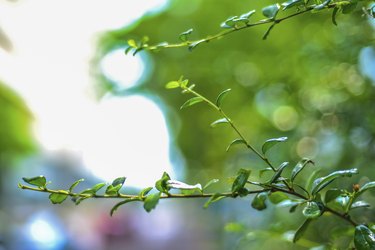Things You'll Need
Bucket
Organic mulch
Spade
Pruning shears
Rubbing alcohol
Wire cutters
Scissors

Planting saplings is investing in the future, when the mature trees will provide shade and privacy, and maybe flowers and fruit to enhance your garden. Transplanting young trees is a shock to their systems; taking care to meet their requirements when planting prevents costly mistakes. The best time for planting saplings is spring, but container-grown trees can survive later planting providing they're well watered throughout the first year. Saplings are available in three main forms: bare-root, balled and burlapped, and container-grown or containerized. Container-grown saplings spend most of their lives in a container and containerized saplings were transplanted from a field.
Step 1
Place bare root sapling root balls in buckets of water five to six hours before planting and cover balled and burlapped sapling root balls in soil or organic mulch such as wood chips or shredded bark if you are not planting on the day of purchase.
Video of the Day
Step 2
Dig a hole three times as wide and 1 to 2 inches less deep than the sapling's root ball with a spade in a site that meets the sapling's growing requirements, such as full sun or partial shade and clay or sandy soil. Allow space for the sapling to grow to its final width and height.
Step 3
Remove a bare-root sapling from the bucket or remove the sapling from its container. Examine a container-grown sapling for roots circling the base of the root ball. Wipe the blades of pruning shears with rubbing alcohol and cut three or four vertical slits halfway up the sides and across over the base of a sapling with circling roots. Place the sapling in the hole so the top of the root ball sits 1 to 2 inches above the surface of the surrounding soil. Remove the sapling, add soil to the hole, tamp it and replace the sapling if needed.
Step 4
Turn the sapling so its largest branches face southwest and spread the roots of a bare-root sapling over the base of the hole. Add dug soil until the hole is one-third full. Cut the twine or rope from a burlapped sapling's trunk and remove as much of the wire basket and covering as possible with wire cutters and scissors. Move a bare-root sapling up and down slightly to allow the soil to fill all the spaces between the roots. Tamp the soil with the heels of your hands, and add more soil until the hole is two-thirds full. Water the soil slowly to settle any remaining air pockets. Fill in the rest of the hole with soil and water thoroughly.
Step 5
Spread a 3- to 4-inch layer of organic mulch such as wood chips, shredded bark, pine needles or shredded leaves over the planting site, avoiding the sapling's trunk. Plant the rest of the saplings the same way.
Step 6
Prune dead, damaged and crossing branches and branches growing at a narrow angle to the trunk.
Step 7
Water the saplings every week during the first growing season, applying 5 to 7 gallons of water slowly to each root ball, or sufficient water to keep the soil constantly moist but never sodden.
Tip
Mix 20 percent peat moss or compost into the backfill soil in a sandy planting site to help retain water. Most saplings develop strong, healthy root systems when not staked. In windy areas, drive a 2-inch-by-2-inch post into the ground 5 to 6 inches from the base of a sapling, avoiding its rootball, and attach the sapling to the stake one-third of its height above the ground with fabric tree ties. Remove the ties and stake after the first growing season. Saplings planted in average soil don't require fertilization immediately. After two to three years, apply a 12-4-8 slow-release, granular fertilizer at a rate of 4 tablespoons per 4 square feet in spring and again three months later, or according to the manufacturer's instructions.
Video of the Day
- University of Minnesota Extension: Planting and Transplanting Trees and Shrubs
- Colorado State University: The Ten Commandments of Tree Planting
- University of Missouri Extension: How to Plant a Tree
- Colorado State University Extension: Tree Placement -- Right Plant, Right Place
- University of Minnesota Extension: Choosing Landscape Evergreens